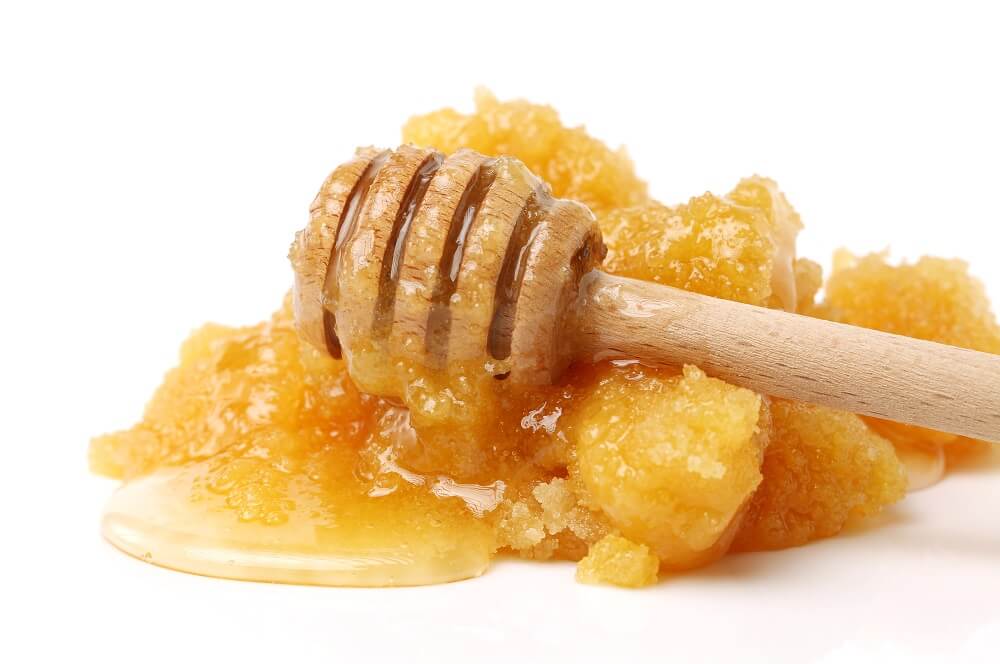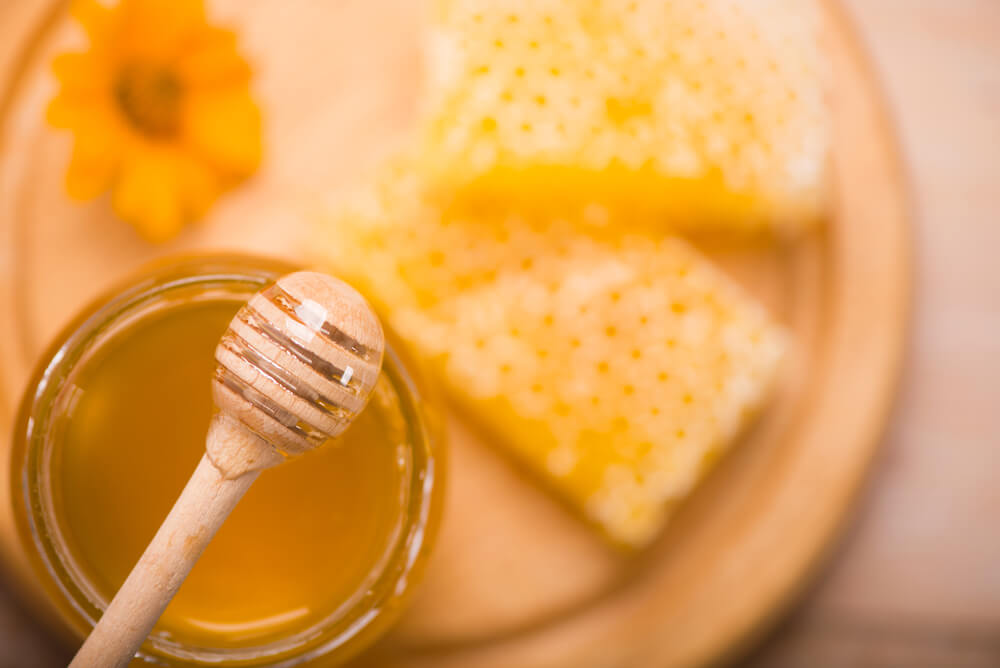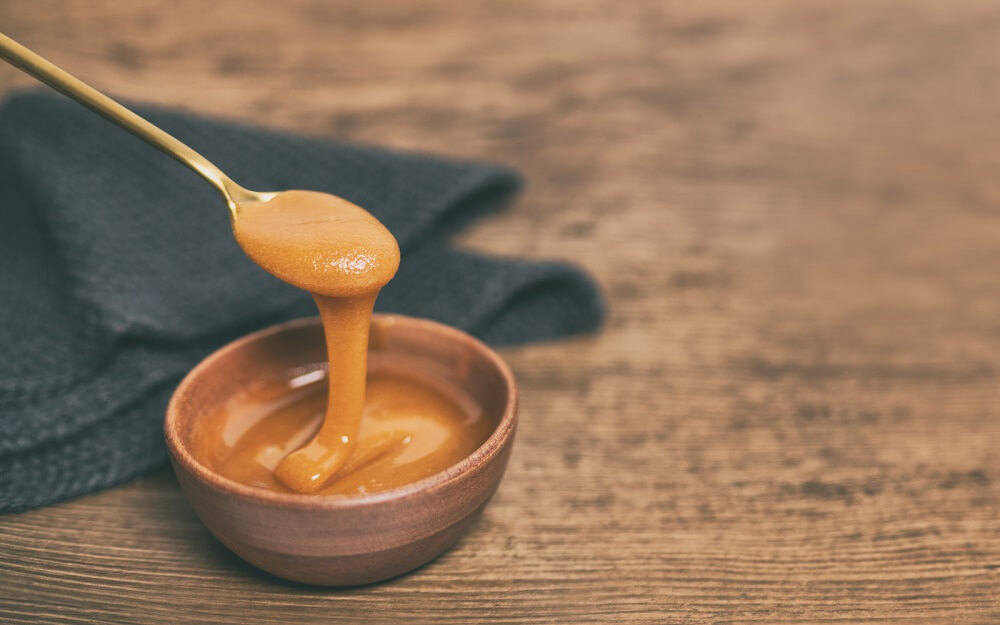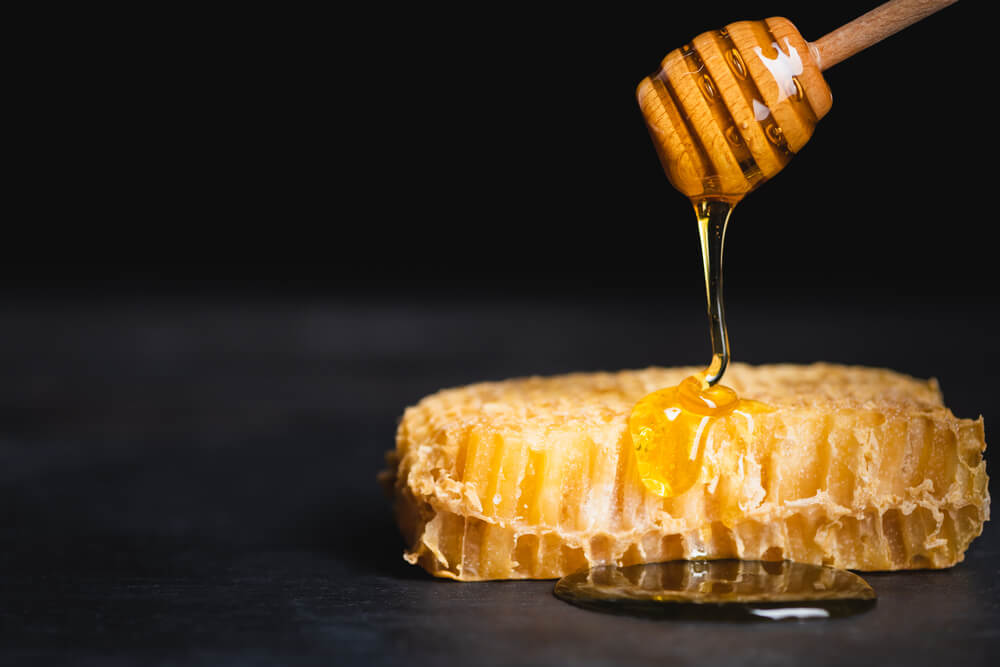Table of Contents:
Why Does Honey Crystallize?
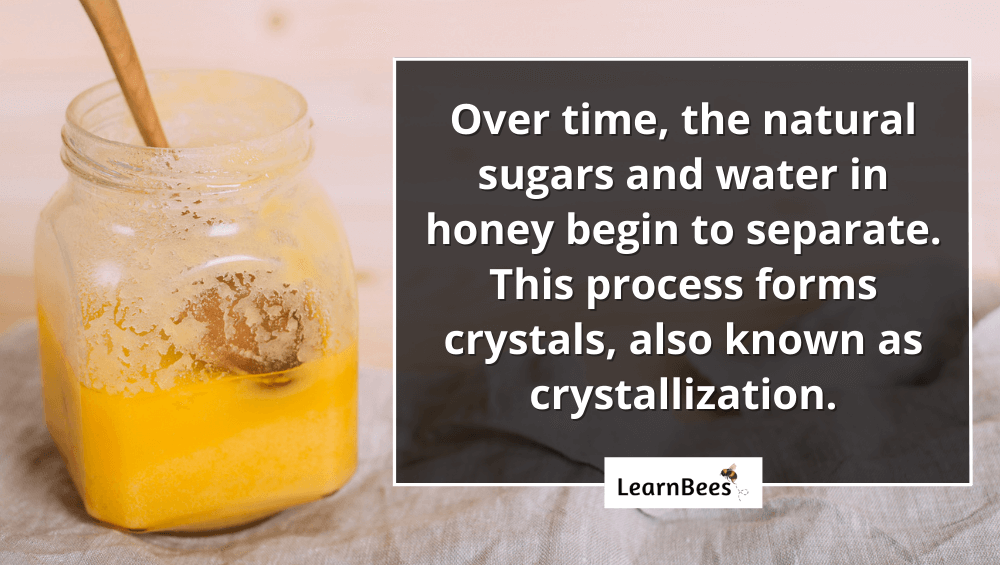
In short:
Crystallization occurs when liquid honey begins to solidify.
Honey crystallizes when its natural sugars and water separate from each other. This process leads to the formation of tiny crystals, also known as crystallization.
But why does the sugar separate from the water?
Because honey has a low moisture content, meaning it doesn’t have enough water to keep the sugars dissolved. As a result, all honey naturally crystallizes over time.
Fortunately, crystallized honey is still safe to eat.
In fact, honey is one of the only foods that never expires when stored correctly. You can easily decrystallize honey to bring it back to its liquid state.
And here’s the interesting part:
Crystallization is a good sign that you have raw honey.
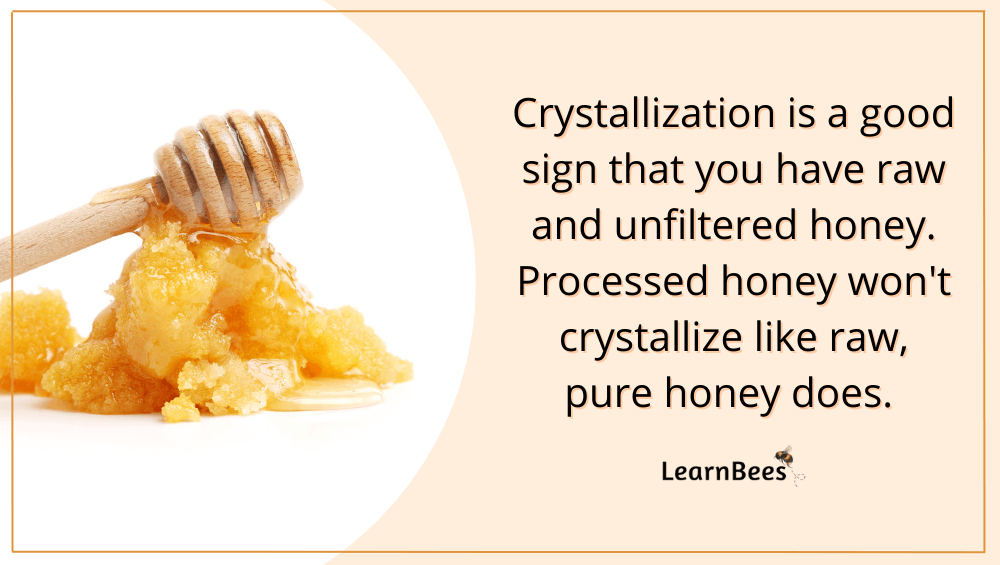
Raw honey is honey straight from the beehive. It has no artificial sugars and maintains all the health benefits that make honey a superfood.(1)
In contrast, processed honey doesn’t crystallize like raw honey does. This is because processed honey is diluted with other ingredients like artificial sugars and flavors. Some manufacturers dilute honey to cut costs.
But here’s the thing:
According to the FDA, honey containing artificial ingredients is no longer considered real honey.(2)
So how do you ensure you’re getting pure honey?
Simple.
Look for honey labels that say “raw” and “unfiltered” on them. This means the honey hasn’t been processed at a high heat, causing it to lose its beneficial ingredients.
In summary:
Honey crystallizes because the sugars and water content separate. Over time, this process leads to the formation of tiny crystals that cause liquid honey to solidify.
Crystallization is a natural process that all raw and unfiltered honey goes through.
You can decrystallize honey to bring it back to its liquid form.
How Long Does it Take for Honey to Crystallize?

Honey crystallizes at different rates depending on the type of honey and storage conditions. It can take a few weeks to a few years for honey to crystallize.
Keep in mind:
There are over 400 different kinds of honey, including popular flavors like clover, wildflower, and manuka honey.
Some types crystallize faster than others.
This is because honey is made up of two different sugars: glucose and fructose. The higher the glucose content, the faster the honey crystallizes. For instance, clover honey has more glucose sugars than blackberry honey, so it crystallizes faster.
Honey varieties that crystallize quickly are:
- Clover honey
- Lavender honey
- Dandelion honey
- Alfalfa honey
Honey varieties that crystallize slowly are:
- Maple honey
- Tupelo honey
- Acacia honey
- Blackberry honey
Storage conditions also play a role in how quickly honey crystallizes. Your honey should be kept in airtight glass jars or plastic bottles at room temperature.
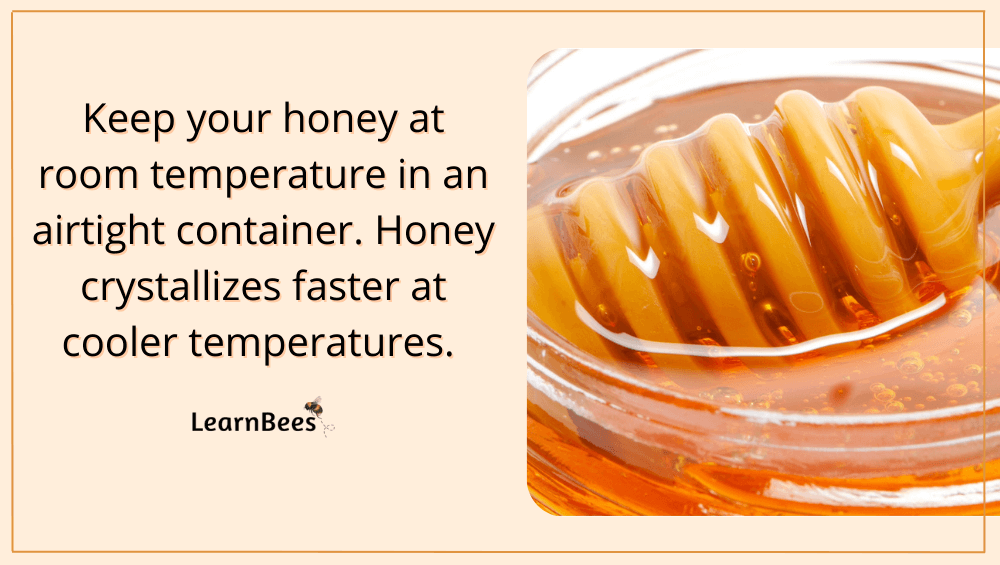
Honey crystallization occurs faster at cooler temperatures below 50ºF (10ºC). Refrigerators are kept at 40ºF (4.4ºC), so honey begins to crystallize within a few days if stored in the fridge.
Remember:
Honey is antibacterial, so it never expires if stored correctly. But, the crystallization of honey is a normal process that happens to natural honey eventually – no matter how you store it.
What does that mean for you?
It means you may have to decrystallize your honey every so often if you don’t finish the jar in time.
The best way to decrystallize honey involves soaking your glass container or plastic container in hot water. Occasionally stir the honey to break up the glucose crystals.
Repeat these steps until the honey is back in its liquid state.
If your honey is only slightly crystallized, you can set it outside under direct sunlight for several hours on a hot summer day. You may also need to stir it every few hours to help break up the sugar crystals.
Does Honey Crystallize in the Beehive?
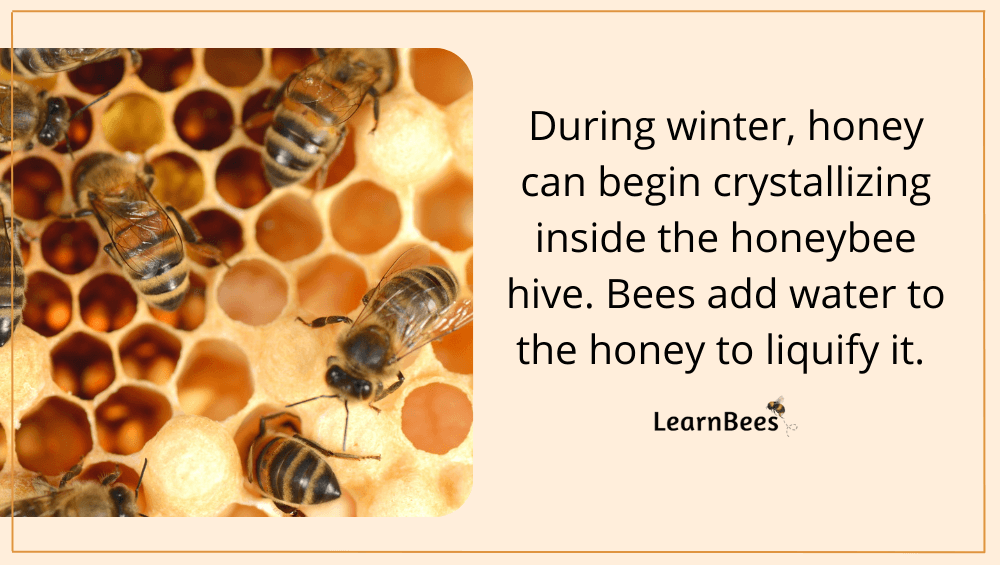
Honey begins to crystallize at lower temperatures below 50ºF (10ºC).
So it’s not unusual for honey to start crystallizing in the beehive during the winter. This is especially true for places with cold winters like North and South Dakota.
It’s also true for the type of honey inside the hive. For instance, clover honey crystallizes at a faster rate than tupelo honey.
But honey bees are industrious little creatures.
During the winter, they use water collected in the hive to dissolve the honey crystals. They gather the water with their mouths and then place it over the crystals so they liquify.
Bees also huddle together and rapidly vibrate their wing muscles to generate heat. This keeps the hive warm throughout the winter until temperatures rise again.
FAQs on “Why Does Honey Crystallize?”
- Can you eat crystallized honey?
- What does crystallized honey taste like?
- Is it normal for honey to crystallize?
- Why does honey crystallize at room temperature?
- Does honey crystallize when cold?
- Why does some honey crystallize faster than others?
- Can you permanently decrystallize honey?
- Why does raw honey crystallize?
- Why does honey crystallize in the bottle?
Can you eat crystallized honey?
Yes, crystallized honey is perfectly safe to eat.
The crystallization of honey is a natural tendency of honey. It doesn’t affect the quality or taste. Remember that honey never expires regardless if it crystallizes or not.
Also, different types of honey will crystallize faster than others. For instance, dandelion honey crystallizes at a faster rate than maple honey.
This is because honey comprises of two sugars: fructose and glucose. Glucose separates from water quickly, forming tiny crystals in the honey.
As a result, honey with a higher ratio of glucose molecules will result in an increased speed of crystallization.
In turn, honey with a higher ratio of fructose and lower glucose will crystallize slower.
Despite this, crystallized honey is still safe to eat. It’s simply liquid honey that’s transitioned into a solid form.
Some people actually prefer the texture of crystallized honey over runny honey. This is because the texture is slightly gritty and pairs well with granola, ice cream, or other foods.
Crystallized honey will also melt when put inside hot tea or coffee.
—> Go back to the FAQs on “Why Does Honey Crystallize?”
More to Explore:
What does crystallized honey taste like?
Crystallized honey tastes the same as liquid honey. Remember that crystallized honey is simply liquid honey in solid form. It’ll have the same taste, but the texture will be more gritty. You’ll have to chew it just a tad.
If you don’t like the texture of crystallized honey, you can always decrystallize it by heating it in hot water or warm water. This is the simplest method.
You may have to decrystallize your honey every few weeks or months, depending on the type of honey. Some honey varieties solidify faster than others.
—> Go back to the FAQs on “Why Does Honey Crystallize?”
More to Explore:
- The Brutally Honest Truth About Sour Honey
- Buckwheat Honey: Uses, Benefits, & Risks
- Can You Eat Honeycombs?
Is it normal for honey to crystallize?
Yes, crystallization is actually a good sign because it means your honey is pure and raw. Raw honey is unheated, unpasteurized, and unprocessed. This allows the honey to keep all its beneficial enzymes, vitamins, and antioxidants.
Contrastly, processed honey is heated and filtered, so it has fewer pollen grains and small particles. That said, most people don’t notice the presence of pollen in honey, but manufacturers filter it to give it a smoother texture.
Unfortunately, this can lead to heating the honey at high temperatures to the point where it loses its nutritional value.
As a result, processed honey won’t crystallize like raw honey does. This is one way to distinguish between pure honey and processed honey.
Also, some manufacturers add artificial sweeteners into a honey like high fructose corn syrup or sugar. This helps manufacturers cut costs, but this is no longer considered real honey.
Real honey has the appropiate fructose and glucose ratios, with no added sweeteners.
—> Go back to the FAQs on “Why Does Honey Crystallize?”
More to Explore:
Why does honey crystallize at room temperature?
People often ask, “What temperature does honey crystallize?”
Let me clarify:
Honey can crystallize at any temperature. This is a process that all honey goes through eventually.
That said, the rate of crystallization speeds up at temperatures of 55°F or lower. In low temperatures, the sugars and water in honey begin to separate, which forms tiny crystals.
Such formation of crystals is where “crystallization” gets its name.
We don’t recommend storing your honey in the fridge or freezer if you want to slow down the crystallization process. Room temperature is the optimum temperature.
Don’t forget:
Certain honey varieties will solidify at a faster rate than other types of honey. For example, clover honey, dandelion honey, and alfalfa honey all crystallize rapidly.
On the other hand, it can take months or years for other types of honey to crystallize. Tupelo and blackberry honeys are two common examples.
—> Go back to the FAQs on “Why Does Honey Crystallize?”
More to Explore:
- The Top 3 Best Manuka Honey Brands
- Orange Blossom Honey: Uses, Benefits, & Risks
- Sourwood Honey: Uses, Benefits, & Risks
Does honey crystallize when cold?
Honey can crystallize at any temperature, but the process speeds up in cold temperatures. The sugars and water in honey begin to separate when it gets cold, forming tiny crystals.
This is where crystallization gets its name.
—> Go back to the FAQs on “Why Does Honey Crystallize?”
More to Explore:
Why does some honey crystallize faster than others?
People frequently ask, “Why does some honey crystallize and some not?”
Here’s the answer:
It all comes down to the chemical composition of honey. Honey is made up of two types of sugar: fructose and glucose.
Glucose separates from water quickly and forms tiny crystals in the honey. As a result, honey with a higher ratio of glucose will crystallize at a faster rate.
On the other hand, it can take months or years for other types of honey to crystallize.
Clover honey is one of the most popular types of honey. It’s known for its fast crystallization rate compared to maple honey or other honeys with a low amount of glucose.
—> Go back to the FAQs on “Why Does Honey Crystallize?”
More to Explore:
Can you decrystallize honey permanently?
People regularly ask questions like:
Why does my honey crystallize? Why does my honey keep crystallizing? How does honey crystallize? Why does honey get crystallized?
The answer is that you can’t permanently decrystallize honey. You can decrystallize honey as many times as necessary, but you can never keep it liquid forever without heating it.
The only way to avoid crystallized honey is to buy small bottles that you can eat before it solidifies.
You can also store honey in a warmer spot to slow down the crystallization process. Honey stays liquid longer when stored at room temperature. You can place it beside a sunny window to keep it at a higher storage temperature.
Or, you can cream your honey which is crystallized honey with tiny crystals instead of large crystals. Small crystals result in the smooth, airy texture that creamed honey is famous for.
In short:
Depending on the size of the crystals, the honey can have different textures.
Creamed honey can be made from crystallized honey using an electric mixer to break up the large crystals. This mixing process can take anywhere from 15-20 minutes.
You can also mix regular liquid honey with seed honey to make creamed honey.
—> Go back to the FAQs on “Why Does Honey Crystallize?”
More to Explore:
Why does raw honey crystallize? Does pure honey crystallize at room temperature?
Raw honey crystallizes because it’s a natural occurrence due to the sugars found in honey. This process happens no matter where you store your honey.
As mentioned, crystallized honey is a good sign of the quality of the honey.
—> Go back to the FAQs on “Why Does Honey Crystallize?”
More to Explore:
Why does honey crystallize in the bottle?
People often ask:
Why does honey crystallize in a jar? Why does honey crystallize in the jar? Why is my entire jar of honey crystallized? Why is my bottle of honey crystallized? Is it normal for a container of honey to crystallize?
Honey crystallizes no matter the container it’s stored in.
You can store your honey in a plastic bottle or glass jar, but the result will still be the same. The process of crystallization happens when the water in honey begins to separate from the sugars.
Honey has a lower water ratio, so it can’t keep the sugars dissolved forever.
Some people prefer crystallized honey because it has a unique texture. It’s slightly gritty, and you have to chew it. It pairs well with breakfast food and dissolves nicely in hot tea or coffee.
